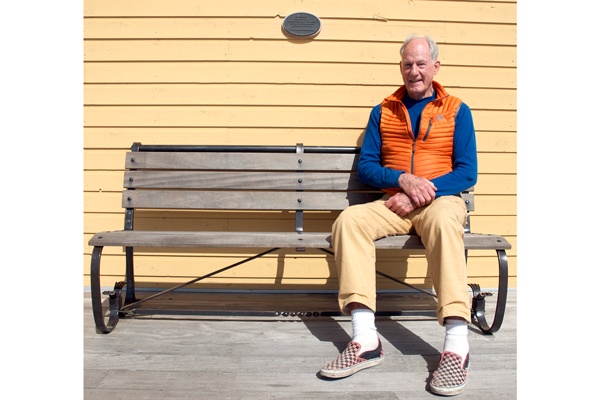Looking down a 1,000-foot drop, roped to his brother on Mount Si in the Cascades, the only thing Jim Whittaker could think was, “Dear God, if you can get me down off this alive, I’ll never climb again.”
Then he climbed Mount Rainier. And Mount Olympus. In fact, he never stopped climbing, leaving a monumental legacy of adventuring and exploring that would inspire generations of adventurers to come.
And 50 years ago today, Jim Whittaker became the 10th person in the world — and the first American — to summit Mount Everest.
“I’m a cockeyed optimist,” says Whittaker, who still cuts an imposing figure at 84, with wisps of his hair caught in the breeze of his current hometown Port Townsend. “Before you check out, you gotta do as much as you can on this magical planet.”
He spent three years preparing for the legendary climb with punishing workouts. He hiked with a backpack full of bricks to prep himself for the equipment he’d carry to make the summit. To condition for the biting, relentless cold and the approach hike through the icy steppes and jungles, he swam in the Samamish River and spent sweat sessions in a sauna. His body was so numb after the swims that he only could tell the shower’s water temperature with his tongue.
Arriving on the summit, Whittaker says there wasn’t time to grasp the gravity of what he had done. Exhausted and with dwindling oxygen, the first American on Mount Everest was more worried about snapping a fast photo, taking in the view and getting down to safety than thinking he had made history. “When you climb a mountain and get to the top that’s only half of it!”
Conditions differed from today, when there are lines from Everest base camps to the summit in which people have died, waiting in the “Death Zone” for their chance to put a foot on top of the world.
“There’s too many people that are trying to climb that mountain,” Whittaker says, but he also admits that the increased tourism has helped the Nepalese economy. “They just have to control it a little bit,” he suggests, like some mountains that only allow a certain number of people on the summit each day.
Scaling peaks
Advances in mountaineering technology have made the climb increasingly easier to attempt. When Whitaker began his ascent in 1963, he hiked through more than 180 miles of jungle, steppe and ice to arrive at the base of the mountain. Today, helicopters fly tourists to within 40 miles. Back then all the best gear was made in Europe, and it was bulky and cumbersome stuff, a far cry from the sleek, ultralight equipment of modern mountaineering.
Whittaker’s Everest ascent never diminished climbs he’s made since. He still enjoyed Rainier, Baker, McKinley and K2 just as much for the experience of climbing and being in nature. “It’s not about peak bagging, it’s about the love of nature,” he says, along with feeling comfortable in the outdoors.
“Big Jim,” as he’s known, doesn’t mind the tourism around Everest. He says that the congestion is dangerous, and needs to be taken care of, but at the same time, it gets people out in the outdoors, and anytime that happens, his goal is accomplished.
Whether it’s getting children out when they’re 5 years old, or getting 80-year-olds up to a mountain path, Whittaker’s lasting legacy will have been an unbridled enthusiasm for the outdoors.
Unlike some of his colleagues, Whittaker allowed the trip to define him and used his influence to get others interested in the outdoors. For the next 50 years he used his fame to attract others and improve outdoors awareness, from helping Bobby Kennedy summit Mount Kennedy to helping raise money for the Northwest Maritime Center.
But Whittaker laments how much restriction exists in America’s park service today. “They acquire the best, most beautiful landscapes and they close it off and charge the people who own it,” he says with exasperation.
It doesn’t help Whittaker that fewer parents are getting their children out of the house, either. He says that after talking to the Boys & Girls Club of Port Angeles, he found out that only eight of the 80 youths involved in the club have ever been up to Hurricane Ridge. “What the hell? Why don’t the parents get them out?”
Originally a hardened conservationist, Whittaker lightened somewhat after returning from a trip to the Alps, where he took a funicular up to the summit and found trails accessible to older and younger people. He hopes that someday the parks can be opened and improved to provide access for the very young and old as well as those in the prime of their lives.
“If they can get out to it, they’ll learn to love it, and if they love it, hopefully they’ll take care of it and pass it on to their children.”
Contact reporter Ross Coyle at rcoyle@sequimgazette.com.



